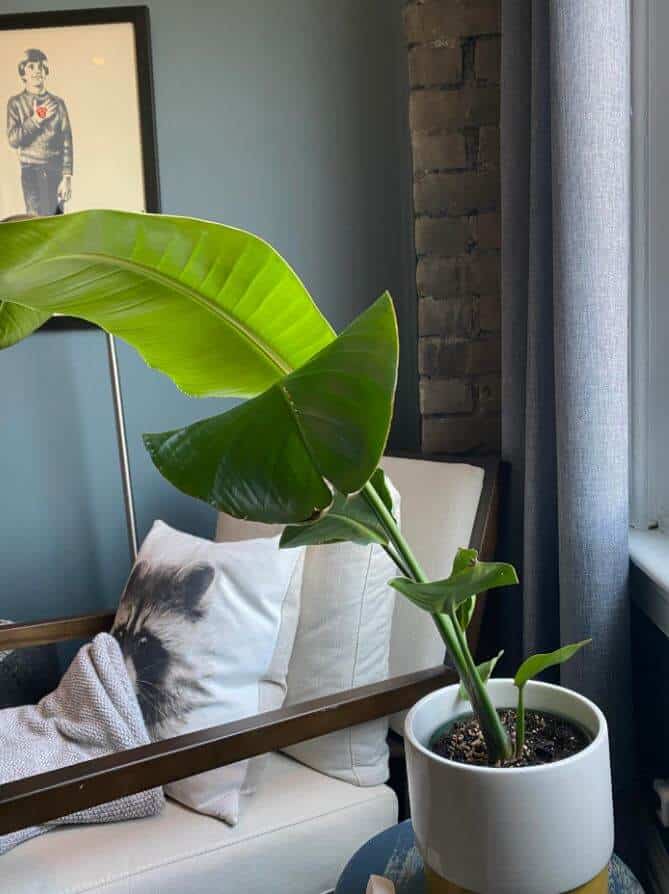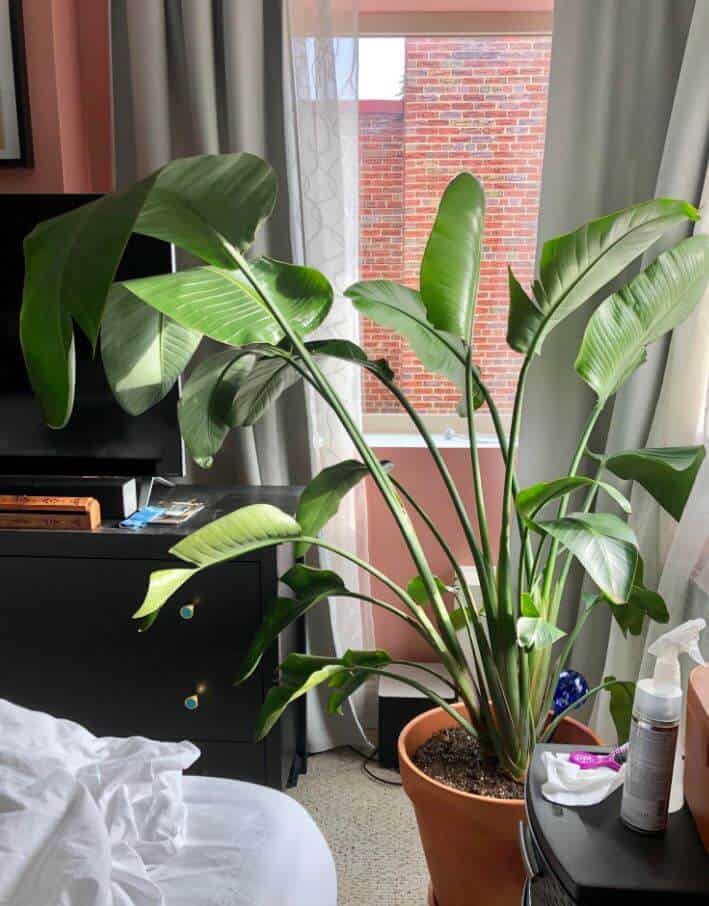Last Updated on October 3, 2023 by a Friendly Gardener
While the leaning tower of Pisa may be more famous, a Bird of Paradise plant leaning will undoubtedly grab your attention. Bird of Paradise plants can grow to be enormous without support. Hence, these plants can tend to lean. However, there are a few reasons why this plant may start moving to one side.
Common reasons why these plants begin to lean include:
- The plant is root-bound.
- Inadequate pruning
- Improper environmental conditions
- Improper feeding
- Improper light
- Improper watering
- Pest infestations
- Shock
- Soil quality
Identifying the issue and treating your plant to prevent the stems from eventually breaking is essential.
Reasons for a Bird of Paradise Plant Leaning

-
The plant is root-bound
While Bird of Paradise plants enjoy being slightly root-bound, the key word here is ‘slightly.’ These plants generally need to be repotted every one to two years. If the plant is not repotted, the roots will not have sufficient space to continue growing and will cease doing so. The plant will then begin suffering from a lack of nutrients and moisture. Examine your plant for roots emerging from the container’s drainage holes or the soil surface.
-
Inadequate pruning
A plant’s foliage is essential for photosynthesis or the absorption of sunlight for energy. Many plants will drop dead or old leaves, but the Bird of Paradise plant does not. This means that it requires regular pruning. If this plant is not pruned regularly, it can become heavy and begin to lean, eventually breaking.
-
Improper environmental conditions

Bird of Paradise plants do not enjoy temperature extremes, so anything below 60°F or above 100°F in the summertime will be problematic. Extreme temperatures or sudden temperature fluctuations can cause a Bird of Paradise to lean due to stress. Humidity levels are equally important. If humidity levels are too low, the plant may suffer from dehydration, causing it to lean.
-
Improper feeding
Indoor plants can benefit from fertilization. Often, potted plants suffer from a decreasing supply of nutrients, making it very difficult for a plant to maintain its overall health. The weakening of a Bird of Paradise plant due to inadequate nutrition will cause it to lean.
-
Improper light
Too little or too much light can cause these plants to lean. When exposed to too much direct sunlight for too long, the plant will lose too much moisture due to increased transpiration. If left unattended, the plant will gradually dehydrate and begin to lean. If the plant receives too little light, it may attempt to lean toward a light source.
-
Improper watering
When watering is a problem, it can be due to providing your plant with too much or insufficient water.
Overwatering can be more of a problem because it can cause root rot. If your plant sits in saturated soil for too long, fungal infections can develop. The root system will be compromised and unable to function correctly. As a result, the plant will be unable to absorb nutrients and water, causing it to lean. Underwatering will cause dehydration, and the plant, in its weakened state, will begin to lean.
-
Pest infestations
Pest infestations are always an issue for houseplants of any kind. Bird of Paradise plants are susceptible to aphids, whiteflies, scales, mealybugs, and spider mites. These pests suck the sap from the plant stealing its nutrients and weakening it. As the plant loses its strength, it will begin to lean.
-
Shock

Shock is a common cause of Bird of Paradise plants leaning. Plant shock can result from repotting your plant or transplanting it indoors to outdoors or vice versa. When the Bird of Paradise finds itself in a new environment, it must adjust, which isn’t necessarily easy or automatic. The plant may begin to lean, but it should recover fully as it adapts.
-
Soil quality
If the soil type is incorrect, this plant may lean. Highly compact soil can cause overwatering, and the plant’s root system becomes waterlogged, resulting in leaning. With excessively loose soil, the water will drain too rapidly, there will be little moisture retention, and the plant will have insufficient moisture, leading to dehydration causing leaning.
How to Fix Leaning Bird of Paradise

Follow these simple recommendations to fix a Bird of Paradise leaning.
- For root-bound plants, you need to repot. Choose a new container approximately three inches larger and prepare to repot your plant with fresh potting soil. Water your plant abundantly before removing it from its current container. Untangle and trim any damaged roots. Repot your plant in the new pot and soil.
- Proper pruning requires trimming off any excess foliage. Remove drooping, damaged, old, or split foliage using clean, sterilized garden shears. Do not remove more than 25% of the foliage when pruning to avoid stressing the plant. Trim foliage at its base. Wait at least a week before trimming anew.
- Proper environmental conditions require temperatures measuring between 65° and 85°F. Use a pebble tray beneath the plant container or a space humidifier if your home’s air is dry to improve area humidity. You can also place this plant in a bathroom or kitchen with higher humidity.
- To fertilize your Bird of Paradise plant, use a liquid fertilizer with a 10-10-10 NPK. Feed your plant monthly during the growing season.
- Proper light for a Bird of Paradise plant means positioning your plant in a spot with a light source. To prevent Bird of Paradise leaning, rotate your plant often. Consider using a grow light if you don’t have a window that provides sufficient light. In the case of excess light, move your plant to a spot that offers bright indirect light.
- Proper watering will depend on whether you have been underwatering or overwatering. Water generously for an underwatered leaning plant until water drains from the container’s drainage holes. Then, continue watering in small amounts, so your plant has time to adjust. Overwatering must be corrected by repotting. Remove the plant from its saturated soil, rinse the root system, trim off damaged roots, and repot with well-draining, fresh soil.
- For pest infestations, isolate the plant, trim off damaged foliage, and clean the plant with cotton balls dipped in rubbing alcohol. Treat the plant with insecticidal soap or neem oil for several weeks.
- Given time, most Bird of Paradise plants will recover from shock gradually due to a new environment. When repotting, place your plant in the exact location in its new pot to aid in avoiding shock.
- To ensure proper soil quality, mix 50% potting soil and 50% peat moss. Add in two fists of perlite to provide drainage.
A Final Thought

To aid in preventing Bird of Paradise plant leaning, consider supporting your Bird of Paradise plant with stakes. Use 3 to 4 stakes taller than your plant and latch stems onto the stakes. Keep an eye on latches so that they do not become too tight.

